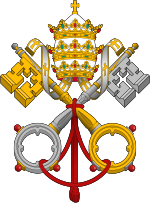Pope Leo IV
| Saint Leo IV | |
|---|---|
 |
|
| Papacy began | 10 April 847 |
| Papacy ended | 17 July 855 |
| Predecessor | Sergius II |
| Successor | Benedict III |
| Personal details | |
| Birth name | ??? |
| Born | 790 Rome, Italy |
| Died | 17 July 855 ??? |
| Other Popes named Leo | |
| Papal styles of Pope Leo IV |
|
|---|---|
 |
|
| Reference style | His Holiness |
| Spoken style | Your Holiness |
| Religious style | Holy Father |
| Posthumous style | Saint |
Pope Saint Leo IV was pope from 10 April 847 to 17 July 855.
A Roman by birth, he was unanimously chosen to succeed Sergius II. When he was elected, on 10 April 847, he was cardinal of Santi Quattro Coronati, and had been subdeacon of Gregory IV and archpriest under his predecessor. His pontificate was chiefly distinguished by his efforts to repair the damage done by the Saracens during the reign of his predecessor to various churches of the city, especially those of St Peter and St Paul.

The Saracens were besieging Gaeta which lead to Leo's ordering that the walls of the city be restored and strengthened between 848 and 849. When the Muslims approached Portus, he summoned the Repubbliche Marinare or mariner cities of Italy: Naples, Gaeta and Amalfi to form a league. The command of the unified fleet was given to Cesarius, son of Duke Sergius I of Naples. The subsequent Battle of Ostia was one of the most famous in Middle Ages Papacy history, and is celebrated in a famous fresco by Raphael and his pupils in his Rooms of the Vatican Palace in the Vatican City. Another episode of Leo's life celebrated by the Urbinate in his series of frescoes for the Incendio di Borgo which depicts the burning of the Anglo-Saxon district of Rome (the "Borgo") that, according to the legend, was stopped by Leo simply making the sign of the cross.
In order to definitively counter the Saracen menace, Leo ordered a new line of walls encompassing the suburb on the right bank of the Tiber to be built, including the until now undefended St. Peter's Basilica. The district enclosed by the walls is still known as the Civitas Leonina (City of Leo). He also restored and embellished the damaged churches of St. Paul and St. Peter's: the latter's altar received again (after the former had been stolen) his gold covering, which weighed 206 lb. and was studded with precious gems.
Leo held three synods, one of them in 850 which was distinguished by the presence of Louis II, but the other two were of little importance. The history of the papal struggle with Hincmar of Reims, which began during Leo's pontificate, belongs rather to that of Nicholas I.
Leo died on 17 July 855 and was buried in St. Peter's. Benedict III was Leo's immediate successor. A medieval tradition claimed that a woman, Pope Joan, succeeded him, disguising herself as a man; Joan is generally believed to be fictitious.
Burial
Leo was originally buried in his own monument however some years after his death, his remains were put into a tomb that contained the first four Pope Leos. In the 1700s Leo the Great's relics were separated from the other Leos and given his own chapel.[1]
References
- ↑ Reardon, Wendy (McFarland). The deaths of the Popes..
- Cheetham, Nicolas, Keepers of the Keys, New York: Charles Scribner's Sons, 1983. ISBN 0-684-17863-X
External links
- Catholic Encyclopedia: Pope St. Leo IV
- Opera Omnia by Migne Patrologia Latina with analytical indexes
| Catholic Church titles | ||
|---|---|---|
| Preceded by Sergius II |
Pope 847–855 |
Succeeded by Benedict III |
|
|||||||||||||||||||||||||||||||||||||||||||||
|
|||||||||||||||||||||||||||||||||||||||||

